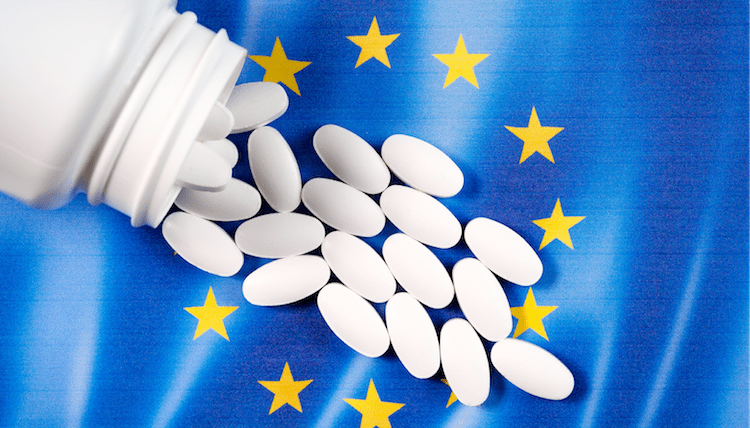The EU and Fine Chemicals: Is Change Coming?
The European Commission’s Pharmaceutical Strategy for Europe calls for a structured dialogue to identify vulnerabilities in the pharma supply chain and provide policy options to strengthen medicines supply in the EU, including reducing EU dependence on non-EU sources for fine chemicals and APIs. What may be in store?
EU to initiate talks
A reduction of reliance on offshore drug manufacturing is on the policy table in the European Union (EU) as part of the European Commission’s Pharmaceutical Strategy for Europe, which the European Commission (EC) adopted in late November (November 2020). It includes a plan for initiating a structured dialogue with and between stakeholders in pharmaceutical manufacturing and public authorities to identify vulnerabilities in the global supply chain of critical medicines and shape policy options to strengthen the continuity and security of the supply of medicines in the EU.
“The coronavirus pandemic has highlighted the vital need to strengthen our health systems,” said Ursula von der Leyen, President of the European Commission, in a November 25, 2020 statement in commenting on the European Commission’s adoption of the EU’s Pharmaceutical Strategy. “This includes access to safe, effective and high-quality medicines at an affordable price. In the challenging economic and social times the EU is currently facing, the strategy adopted today [November 25, 2020] will ensure that Europe and Europeans will continue to benefit from such medicines. I call on Member States and the Parliament to endorse this approach, which will be rolled out in the next three years and beyond.”
The European Commission’s approval of its Pharmaceutical Strategy for Europe marks the beginning of a process. Its implementation includes an agenda of legislative and non-legislative actions that will be launched over the coming years, of which reducing offshore dependence of medicines and pharmaceutical ingredients is just one measure of a comprehensive strategy for pharmaceuticals for the EU. The strategy is built around four main objectives: (1) ensuring patient access to affordable medicines and addressing unmet medical needs (such as in the areas of antimicrobial resistance, rare diseases); (2) supporting the competitiveness, innovation and sustainability of the EU’s pharmaceutical industry and the development of high-quality, safe, effective, and greener medicines (3) enhancing crisis preparedness and response mechanisms, building diversified and secure supply chains, and addressing medicines shortages; and (4) ensuring a strong EU voice globally by promoting a high level of quality, efficacy, and safety standards. Each goal has an associated work strand and includes a series of initiatives to realize those objectives.
The implementation of the strategy has begun and will include a proposal for revision of EU pharmaceutical legislation in 2022. To that end, the European Commission issued a Communication on the Pharmaceutical Strategy for Europe in November (November 25, 2020) to the European Parliament, the European Council, the European Economic and Social Committee (EESC), and the European Committee of the Regions (CoR). The European Council consists of heads of state or government of EU countries, the President of the European Council, and the President of the European Commission. The EESC is an advisory body representing employers’ and workers’ organizations and other interest groups. The CoR is an advisory body representing regional and local authorities in the EU.
The European Commission’s Communication to these groups advises them of the specific initiatives and timetables for these initiatives as part of the implementation plan to achieve the goals of the EU’s Pharmaceutical Strategy and includes the actions, pilot projects, and studies needed to implement the strategy. The Communication was developed as part of a series of consultations in developing the EU’s Pharmaceutical Strategy. Since the publication of a strategy roadmap in June 2020, the European Commission has conducted a series of consultations and meetings to inform the inception of the strategy. An online public consultation on the EU’s Pharmaceutical Strategy closed on September 15, 2020. The process for beginning discussions at a political level with EU bodies for implementing the EU’s Pharmaceutical Strategy began in December (December 2020) with a meeting of the Employment, Social Policy, Health and Consumer Affairs Council, which is composed of EU ministers responsible for employment, social affairs, health and consumer policy from all EU member states.
The EU’s Pharmaceutical Strategy seeks to secure the supply of medicines across the EU and avoid shortages and build on the European Council’s goal of “open strategic autonomy” for the EU in the area of medicines. This involves identifying areas of dependence, including the reliance of the EU on offshore sources of pharmaceutical ingredients and active pharmaceutical ingredients (APIs) in order to reduce supply-chain vulnerabilities by diversifying production and supply chains, ensuring strategic stockpiling, as well as fostering production and investment in Europe. In its November 25, 2020 Communication to EU bodies on the EU’s Pharmaceutical Strategy, the European Commission emphasized that the COVID-19 pandemic further underscored the complexity of the pharmaceutical supply chain, including the EU’s dependence on raw materials, intermediates, and APIs from sources outside the EU, a concern that pre-dated the pandemic.
“Pharmaceutical manufacturing and supply chains are complex, increasingly globalized and sometimes not sufficiently diversified,” said the European Commission’s Communication to the European Parliament, the European Council, the EESC, and the CoR. “Multiple actors, in different parts of the world with varying environmental performance of the production processes, may be involved in the various production steps for a single ingredient. Certain technologies necessary for the production of raw materials are no longer available in the EU. Even before the COVID-19 pandemic, there were concerns about the resilience of pharmaceutical manufacturing chains; both the European Parliament and [EU] Member States have called on the [European] Commission to address this issue.”
As part of its implementation plan for the EU’s Pharmaceutical Strategy, the European Commission says it will initiate and steer a structured dialogue with the actors in the pharmaceuticals manufacturing value chain, public authorities, patient and health non-governmental organizations, and the research community. In its first phase, the structured dialogue will aim to gain a better understanding of the functioning of global supply chains and identify the precise causes and drivers of different potential vulnerabilities, including potential dependencies in the supply of critical medicines, APIs and raw materials through data collection and analysis. In the second phase, the structured dialogue will serve to put forward a set of possible measures to address the identified vulnerabilities and formulate policy options to be considered by the European Commission and other authorities in the EU to ensure the security of supply and the availability of critical medicines, APIs and raw materials.
In moving forward with these measures, the European Commission emphasized that any potential measures would have to be in full compliance with EU competition and World Trade Organization (WTO) rules. The European Commission says that in order to improve the predictability of the trading environment in health products, including medicines, the EU will work together with WTO members to facilitate trade in healthcare products through increased cooperation with trade partners to avoid unnecessary disruptions in the production and distribution of essential goods.
Specific initiatives to address supply-chain vulnerabilities
To achieve the EU’s goal of “open strategic autonomy” in the areas of medicines, the European Commission, through the EU’s Pharmaceutical Strategy, has set forth several initiatives with specified target dates with the aim of developing specific policy measures with respect to EU drug supply chains and related practices. These initiatives are outlined below.
Enhance security of supply and address shortages. The first initiative would involve revising pharmaceutical legislation to enhance security of supply and address shortages through specific measures, including stronger obligations for supply and transparency, earlier notification of shortages and withdrawals, enhanced transparency of stocks, and stronger EU coordination and mechanisms to monitor, manage, and avoid shortages. Target date is 2022.
Address vulnerabilities in the pharmaceutical manufacturing value chain. A second initiative would follow up on the European Council’s request for open strategic autonomy and launch a structured dialogue with and between the actors in the pharmaceuticals manufacturing value chain and public authorities to identify vulnerabilities in the global supply chain of critical medicines, raw pharmaceutical materials, intermediates, and APIs in order to formulate policy options and propose actions to strengthen the continuity and security of supply in the EU. Target date is 2021.
Increase supply-chain transparency. A third initiative would involve considering actions to ensure that the industry increases the transparency of pharmaceutical supply chains through voluntary processes. Target date is 2021.
Increase funding for addressing structural shortages. Other initiatives involve encouraging EU member states and provide support to engage in close cooperation through funding provided by EU4Health, a dedicated funding program for 2021-2027 for building resilient health systems in the EU, to develop guidelines, measures and tools that could be used both at EU level and in national policy making to address structural shortages. Target date is 2021-2022.
WTO actions. Another initiative would seek to promote WTO-based actions to increase the resilience in global supply chains in essential goods. Target date is 2021.





